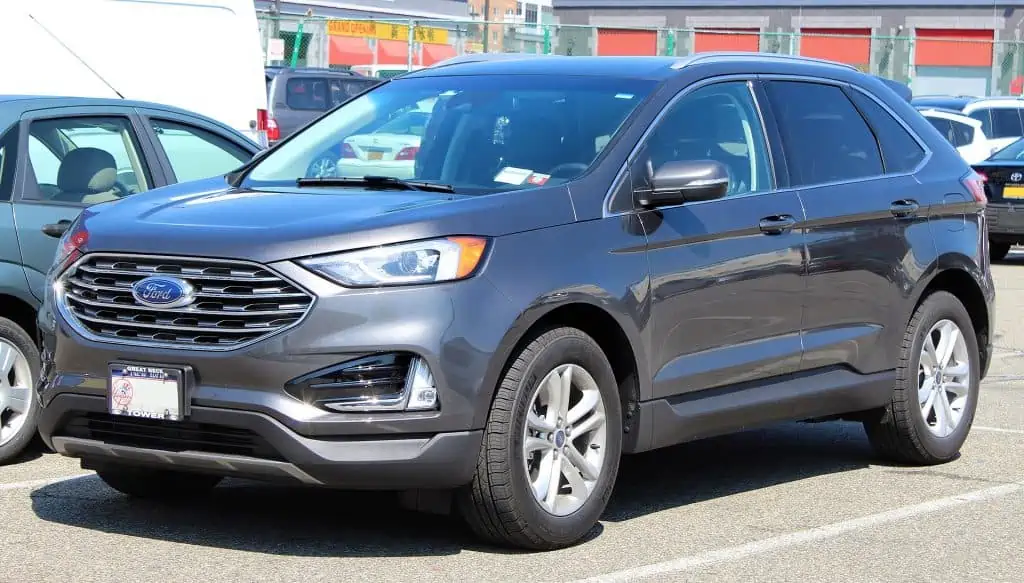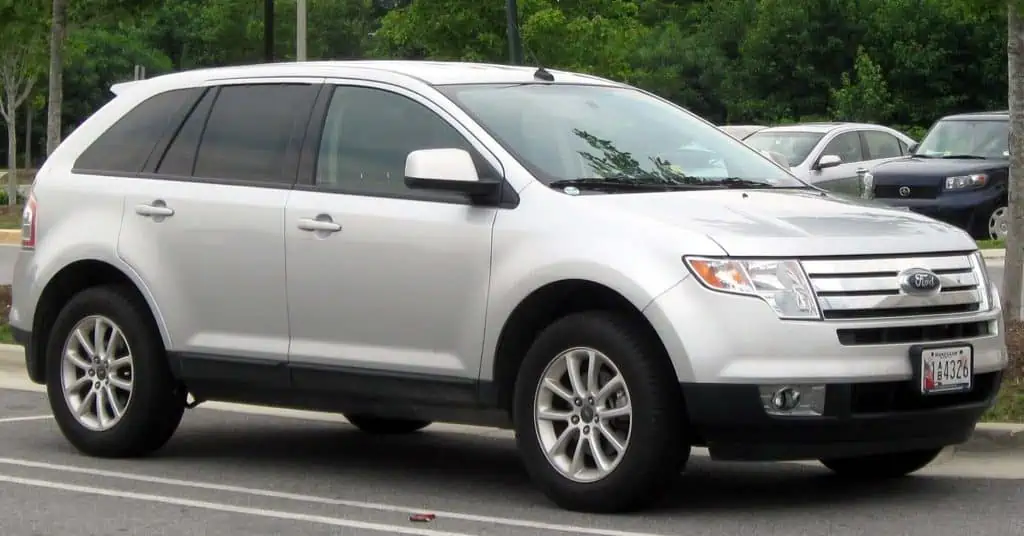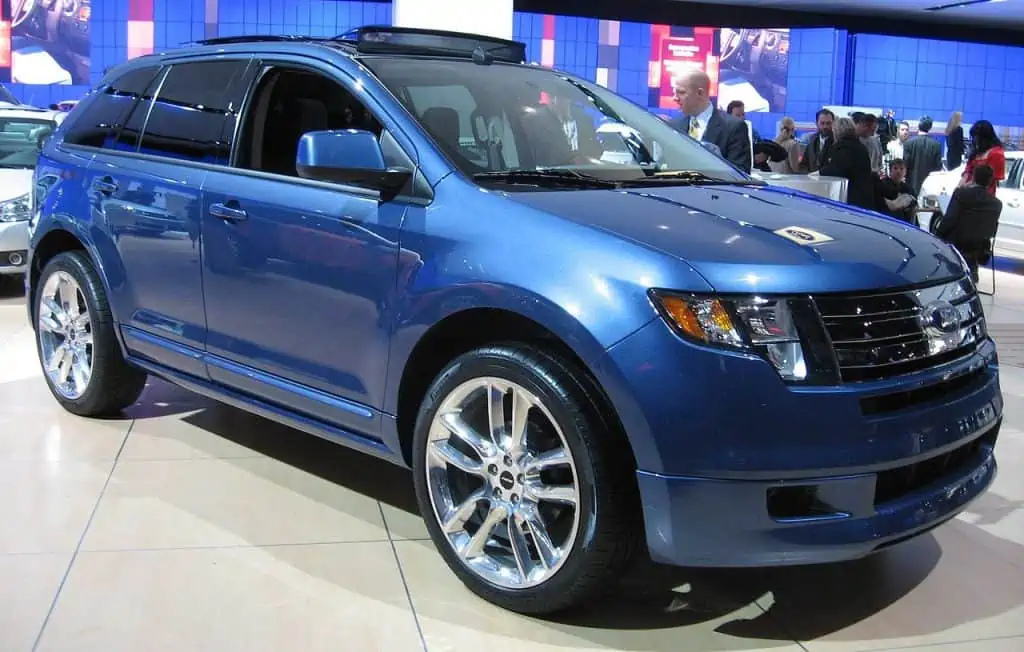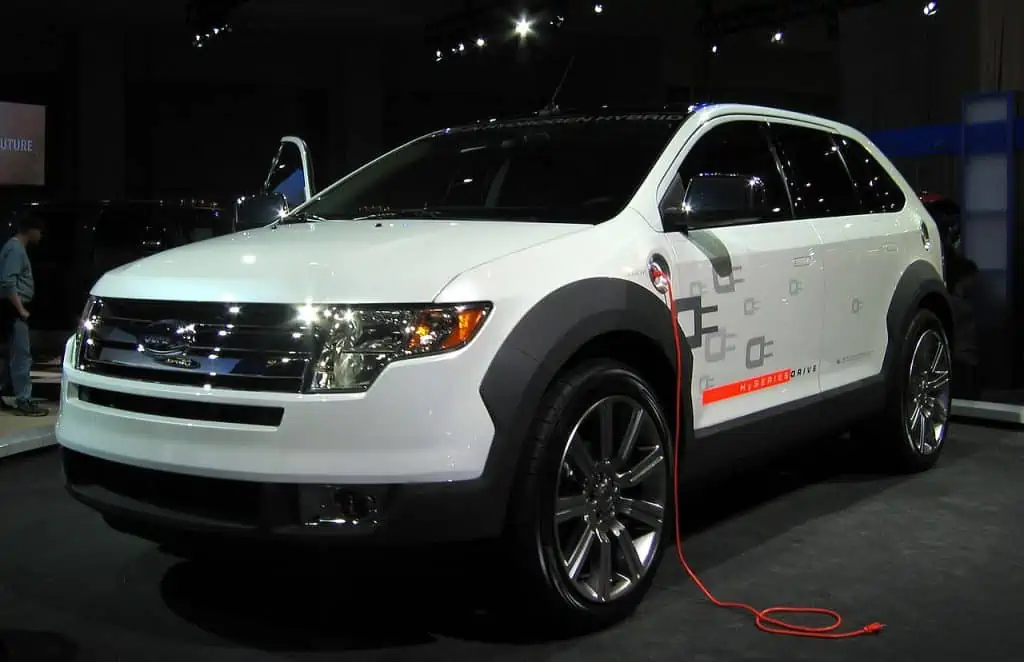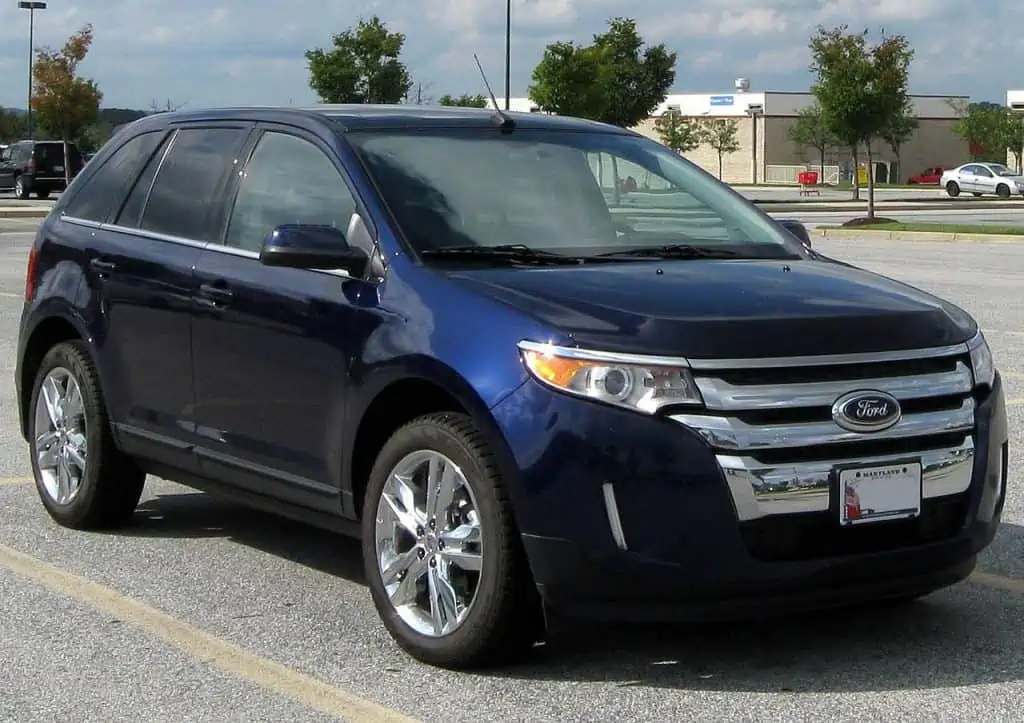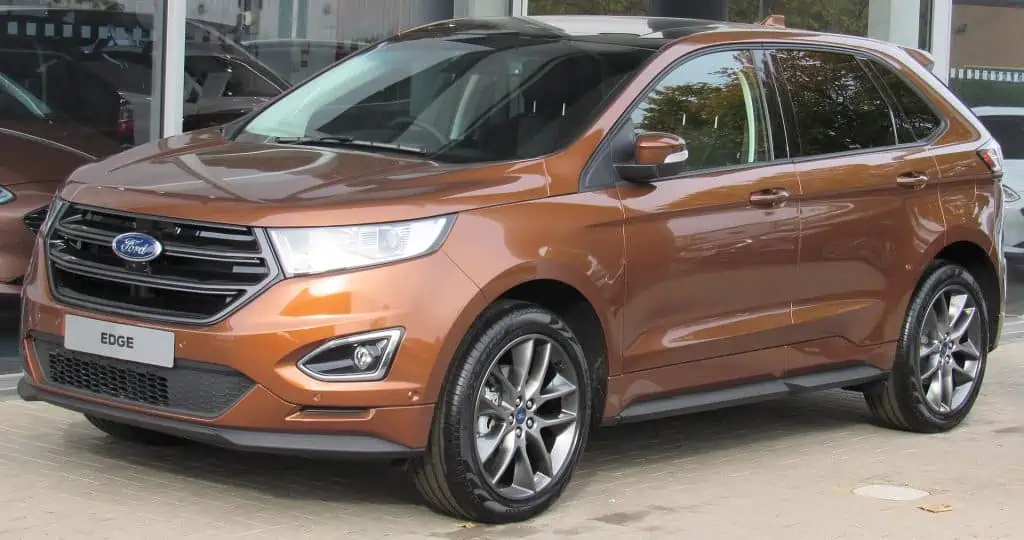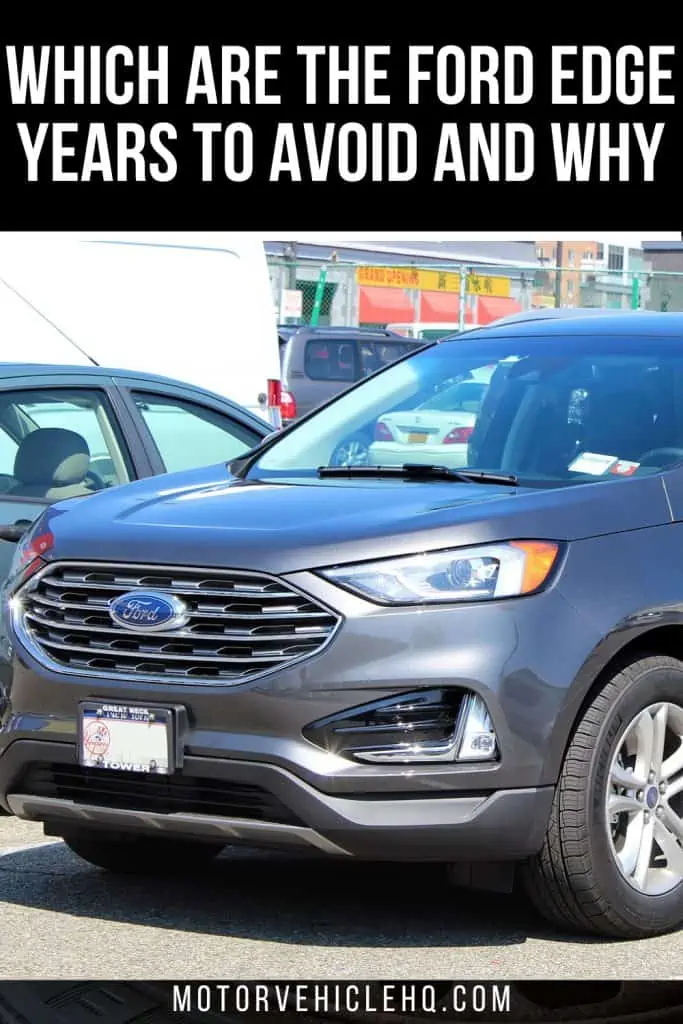Are you interested in buying a used Ford Edge and want to know more about the Ford Edge years to avoid? If so, you’ve come to the correct spot since this post is going to be all about the Ford Edge years to avoid in case you want to purchase one. You don’t want to overlook it.
Your primary objective should be to conduct a thorough study before going to the market and buying a new or used automobile. especially now that automobiles cost so much. When you spend money on a new automobile, it should be a reliable model rather than a lemon.
You will never be able to go past buying a basket case. The more costly the automobile, the more damage it will do to your wallet and you. So be on the lookout for issues associated with the Ford Edge years to avoid.
So that you can decide if this is a nice automobile and make the best buy, we are here to detail all of the issues with the Ford Edge years to avoid particular models.
We will first discover what the Ford Edge is. The engines and transmissions this vehicle provided will then be covered as we go through all of its incarnations. We will discover the trim levels, safety features, and fuel efficiency.
Next, we’ll discuss the Ford Edge issues and discover which model years are the most troublesome. So, keep reading if you want to discover more.
The Ford Edge: What Is It?
Now, let’s start with the fundamentals when it comes to this model and discover what the Ford Edge is before we get into the Ford Edge issues. A smart place to start is by understanding the fundamentals.
Particularly for novices who are not vehicle enthusiasts and wish to learn the fundamentals. We will talk about the issues in greater detail later, but let’s first understand what the Ford Edge is.
The first mid-size crossover that Ford released into the market was the Edge. Before the Edge, Ford produced SUVs, but these were specific models. specifically, the Excursion, Explorer, and Bronco.
The majority of the younger audience didn’t find these models appealing because they were all so large. Ford, like many other businesses during these years, decided to produce something more like a car than an SUV.
2019 Ford Edge SEL EcoBoost AWD by Kevauto / CC BY-SA 4.0. Before 2019, the Ford Edge was well-liked and sold more than 100,000 automobiles a year in the US.
And the crossover class is this. A crossover resembles a mix between a traditional SUV and a car.
Therefore, a person who has driven a car may get into one of these cars and drive it without feeling odd or encountering any difficulties. And the Ford Edge performed a great job at its mission.
Driving was really simple, and it was similar to driving a regular automobile. It was front-wheel drive as standard. The AWD variant, which offered a passable off-road experience, was available for those who want a more competent car.
But what about the issues with the Ford Edge? Well, after we discuss what makes the Edge so well-liked, we will get to it.
Why Is the Ford Edge Such a Favorite to Many?
Therefore, let’s study more about what makes this model so popular before learning more about the Ford Edge issues. Why do Ford buyers choose to purchase this car?
Well, several elements contribute to the popularity of this model. The fact that this model falls within the mid-size bracket is crucial. What does this mean, then?
It indicates that the vehicle is neither too little nor too enormous. As a result, it fits. It is more practical than the subcompact or small class and can fit in most garages.
Compared to the Ford Escape, you can pack a lot more in the Edge. Additionally, your engines are more potent than in Escape. This car is much more entertaining and pleasurable to drive since it has greater power.
Also, compared to its rivals on the market, this model always had attractive aesthetic appeal and appeared more premium. And it’s reasonably priced and accessible. Starting at roughly $38,900, the new model is priced. which, when we consider the costs of contemporary automobiles, is fairly inexpensive.
Additionally, this model sells well. Since its beginnings, it has consistently generated sales in the US that range from 100,000 to 130,000 each year. And to be perfectly honest, not many automobiles in the US can be said to sell this well.
Finally, we can state that Ford works to make the model better and add new features so that customers will buy it. But what issues does the 2008 Ford Edge have? In a moment, we shall discuss it. Let’s now discuss the model’s initial generation.
Which are the Ford Edge Years to Avoid?
The midsize crossover market was still rather modest when it was first established in 2007, and there were far fewer vehicles available than there are now.
However, the Ford Edge has been well-liked, selling more than 100,000 vehicles annually in the US before 2019. Fortunately, the majority of those million+ automobile buyers received dependable midsize CUVs.
Several older versions have been in production for fourteen to fifteen years or more that are still in use today. So, if you’re interested in purchasing a used Ford Edge, we’ll help you decide which Ford Edge model years are the most dependable to buy and which Ford Edge model years to avoid.
The Ford Edge years to avoid are as follows:
- 2007
- 2008
- 2011
- 2012
- 2013
- 2015
Before it could be regarded as a high-quality car, the Ford Edge had to experience some growing pains and work out the flaws, as most new models do. In 2007 and 2008, brake, engine, and transmission issues were shockingly prevalent. Not to mention the countless more difficulties we shall cover later.
2007 Ford Edge by IFCAR. Along with drivetrain and gearbox troubles, the 2007 Ford Edge has received numerous complaints about airbag concerns.
In general, these cars may have been hurried into production before they were ready because the Escape and Explorer SUVs, which sold well, had comparable, if not less, complaints around this time.
For a few model years, Ford was able to turn the ship around. Nevertheless, troubles returned in 2011, including engine issues, braking issues, and gearbox glitches. A defective door sensor that consistently thought the passenger door was open was the most prevalent issue.
It wasn’t the most significant problem, nor was it the most costly to fix, but it was a common complaint nevertheless, costing a few hundred dollars to deal with. In addition to the brake pedal being troublesome that year, the common was also rather widespread for the 2012 model year.
But this issue was most frequently reported with the 2013 model, along with an engine that stopped or malfunctioned. The Ford Edge model years of 2007, 2008, 2011, 2012, 2013, and 2015 were subpar compared to the preceding years’ quality.
Why Do These Years Feature In the Ford Edge Years to Avoid List?
The Edge had trouble getting going, particularly with its gearbox. There have been instances of the transmission sliding, stuttering, trembling, and failing.
In addition, there have been several instances of the brake booster failing, the braking rotor deteriorating, loud roaring noises coming from the back tire, and coil pack fires.
The first two Ford Edge model years are the most crucial to steer clear of, even if 2011, 2012, and 2013 model years had their fair share of issues. The 2007 Ford Edge should be avoided since it was rife with issues.
And in year two, these concerns persisted, with many owners experiencing engine and gearbox failure as well as even more minor problems than in year one.
That flawed door sensor was included in the 2011 facelift. Over the next three years, there were more and more reports of the door-ajar light remaining on permanently. If only that were the issue, it may be overlooked.
But many automobiles from the 2011 model suffered from brake failure, faulty transmission, and engine power loss or death while in motion.
In addition to the numerous complaints regarding the door ajar sensor, the braking issues were not as severe in 2012, nor were the engine or gearbox issues, although they were still present at a lesser level.
Unfortunately, a bigger percentage of those complaints than for the 2011 model appeared for the 2013 model. These are the worst Edge model years to stay away from because of the faults with the engines, brakes, transmission, and door sensors.
The Ford Edge’s second generation had a rocky beginning. Numerous instances of the replacement engine failing while the owner was driving were made.
Additionally, stories of windows breaking on their own, water flowing into the lodge, and batteries sometimes even destroying the entire electrical system continued to surface.
You’ll probably be better off paying for one of the more recent model years and staying away from the 2015 Ford Edge if you want the new second-generation vehicle.
2007
Any model’s first year is frequently a bit challenging since unforeseen flaws need to be fixed. The 2007 Ford Edge has several complaints about airbag issues in addition to drivetrain and gearbox issues.
Due to the risk of the airbag inflator bursting, Ford had to recall approximately 2,500,000 Edges. In extreme circumstances, that might cause metal fragments to fly through the airbag and cause harm or even death.
2009 Ford Edge Sport by IFCAR. The brakes on the 2009 Edge were the focus of the greatest complaints.
Few businesses have previously had to recall such a large number of automobiles, therefore the issue was quite widespread.
As you already know, it may be expensive to replace an airbag, so it would have been wise to take advantage of the recall when it was offered. Risking it now with such an outdated model might be harmful both monetarily and in terms of safety.
A recall was also issued for the 2007 Ford Edge because of gasoline tank leaks caused by corrosion. On some of these cars, the foam seal between the windshield and the dash was also damaged, necessitating the removal of the windshield, replacement of the seal, and reinstallation of the glass.
The Ford Edge had fluid leaks around the axles for the first time that year, which were caused by the transmission or the power transfer unit. Power transfer units were severely back-ordered, making it difficult and time-consuming to rectify the problem. Some drivers had to wait months for the components to arrive.
2008
The Ford Edge had a particularly poor model year in 2008, and most experts will advise you to stay away from it. Numerous drivers reported experiencing sudden engine stops in the middle of a journey, and transmission issues including slippage without prior notice were common.
Repair costs for reported transmission failures were typically approximately $2,800. The same airbag recall from the prior model year as well as the fuel tank corrosion problem affected this model year.
2011
The 2011 Ford Edge’s electrical issues were a major annoyance for many drivers. Some cars, even when the door was shut tightly, would never turn off the “door ajar” light for whatever reason.
This meant that the lights, as well as a caution light and the warning chime that warns you the door is open, would remain on even while you were driving. This problem, the National Highway Traffic Safety Administration received a large number of complaints.
The 2011 model’s engine problems were more severe even if they were less frequent. Unexpectedly, the car would lose power and the yellow wrench light would turn on.
2011 saw the end of the airbag recall but recalls for a body control module that might overheat and catch fire were still in place.
2012
The Ford Edge continued to experience electrical issues that resulted in the door ajar alert and light remaining on constantly for the second year in a row.
The braking issues persisted with this year’s model as well; the majority of drivers reported that the brakes only functioned under intense strain.
The 2012 Ford Edge was the subject of various new issues that had never before arisen. The half shaft might separate from the link shaft as a result of a retention circlip issue.
As a result, the wheels would no longer get any power, increasing the likelihood of an accident as well as the chance of rolling away in a park.
A second recall involving around 30,000 vehicles was initiated because of a fuel pulse damper leak that might ignite a fire.
2013
2013 was the Ford Edge’s poorest model year, according to CarComplaints. The most irksome issue that most owners brought up was that Ford has still not resolved the electrical problem from the previous two years.
No matter how tightly closed the door is, the “door ajar” light that is supposed to alert you that the door is open remains on. On the internet, around 400 owners filed that particular complaint, and hundreds more informed the National Highway Traffic Safety Administration about it.
Ford Edge Hybrid by AudeVivere / CC BY-SA 2.5. Reviews of the Ford Edge’s dependability were generally favorable. It was rated 3.5 out of 5.0 on RepairPal, which put it 11th out of 26 cars in the same category.
The engine, gearbox, brakes, and other issues persisted in the model for this year. Additionally, the “shift to park” warning light would not turn off, draining the battery, rendering the key fobs unusable, and making it unable to adjust the seats.
All of this suggests that the 2013 Edge has significant electrical problems. This is the model year that you should steer clear of the most.
2015
Sadly, Ford’s efforts to enhance the 2014 model didn’t translate to the 2015 version. The second generation of Ford Edge automobiles made its debut this year, and as is customary with vehicle redesigns, this one had issues.
A significant safety worry for the 2015 Ford Edge was engine problems. The engine would stall out while moving, according to drivers. In several of these instances, the throttle body needed to be replaced, and it frequently occurred at little mileage.
For whatever reason, glass was considerably more of a concern in the 2015 model than in earlier models. Not only did the back windshield suddenly shatter, but numerous drivers also noticed that the top glass was breaking.
Water seeping into the inside and electrical issues ranging from early battery death to complete electrical failure were among the 2015 Ford Edge’s other issues.
The 2015 Ford Edge was subject to a significant recall involving over 500,000 cars because of a potential issue that might cause the steering gear motor to separate, resulting in a loss of power steering.
What Ford Edge Model Years are Safe to Buy?
The reduction in complaints between the second and third year of production must have been due to the 2008–2009 improvements. The 2009 Edge’s brakes were the subject of the most reports of issues.
There were just three complaints, two of which stated that the pedal was difficult to press and one of which said the pedal was bad, even though brakes are crucial to a safe working vehicle.
This was more of a question of taste than a braking problem that prevented the car from stopping. Therefore, even though you should watch out for this during a test drive, you shouldn’t avoid the 2009 Edge because of this.
A few more serious concerns surfaced in 2010, such as the engine stalling or dying or a defective brake booster that made it more difficult to depress and apply the brakes.
However, engine issues tended to crop up quite late in the car’s life, and there were still much fewer complaints than in prior years.
The Edge experienced significantly more issues until the final year of this generation after receiving a makeover for the 2011 model year. Although it wasn’t ideal, the 2014 Edge model year is not one to shun.
There were a few complaints that a broken sensor continued to believe the door was open, although the number of reports of this issue decreased from triple digits to single digits in 2014.
The heater and back windshield breaking for no apparent reason were the other most frequent problems, along with the radio occasionally not working properly.
Similar to the original generation, the Ford Edge’s second iteration was released from the factory with a few glitches and an embarrassing amount of complaints, leading some to question if the new design required a redesign.
Ford persisted, nevertheless, and has now produced better cars. In 2016, there were a few oil leaks and engine stalls, although fewer than in 2015.
The 2011 Ford Edge’s air conditioning system frequently overheats. Several owners have claimed that when it’s hot outside, their air conditioners either blow hot air or cease functioning altogether.
The back windshield was still a source of some issues, and the sunroof window now cracks for no apparent reason, but overall, the 2016 model experienced fewer issues than 2015 one.
There have been very few complaints about the models since 2017, which may be due to their youth. It has been supported by 2019’s fashionable overhaul.
A Ford Edge: Is It Worth It?
You can see that there have been years when the Ford Edge has proven to be a highly dependable car. Every year, even though the car had numerous issues, it continuously received very good ratings in crash tests.
All of the most recent years have been exceptional. Avoid the 2007 and 2008 models if you’re interested in a Ford Edge since they were troublesome even when they were brand-new and probably haven’t gotten much better over time.
Additionally, the model years 2011, 2013, and 2015 were so rife with issues that you should avoid all three at all costs.
If you’re looking for an older model Ford Edge, only the 2014 model year stands out as one worth even considering at more than five years old.
If you’re looking for an SUV, the Edge has a lot of advantages, so give it some thought. Just make sure you know which years had those significant recalls and which years are best avoided totally.
Are Ford Edges Trustworthy?
Reliability reviews for the Ford Edge were mostly positive. On RepairPal, it received a rating of 3.5 out of 5.0, placing it 11th out of 26 vehicles in the same category.
The Edge is renowned for offering exceptional performance, precision handling, and practicality together with great fuel efficiency.
In addition, it has high durability and lifespan. If properly maintained according to the recommended service plan, it may last over 200,000 miles with few problems.
Which are the Common Ford Edge Issues?
Even though it is a trustworthy SUV, the Ford Edge does have a fair number of issues. The most frequent issues for each of its model years are shown below:
1. Defective Airbags
In February 2017, Ford issued a recall for the 2016–2017 Ford Edge due to faulty airbags. If activated, the driver may be at an increased risk of harm and injury since the driver’s airbag may not fully inflate or detach from the airbag assembly.
The Federal Motor Vehicle Safety Standard (FMVSS) regulations are violated by these flaws, rendering the Edge units dangerous to drive. Ford informed owners that any dealer would be able to repair the airbags for free on any afflicted SUV.
Before that, in January 2017, the passenger frontal airbag assembly in 2007–2008 Ford Edge vehicles was recalled due to faulty airbag inflators. The inflators may have exploded because of propellant degradation brought on by humidity and temperature changes.
This might result in metal fragments dispersing and striking car occupants. Any dealer will replace the passenger frontal air bag inflator for free on affected cars.
2. A Defective Brake Booster
One of the most well-known issues with Ford Edge models from 2007 to 2015 is a defective brake booster, whose diaphragm may rip as a result of shifting driving circumstances. When the brake pedal is used, this might cause the car to make odd hissing noises.
2017 Ford Edge by Vauxford / CC BY-SA 4.0. Due to defective airbags, Ford issued a recall for the 2017 Ford Edge. The driver may be more likely to suffer harm and injuries if the airbag is activated because it might not fully inflate or separate from the airbag assembly.
Owners have reported that the rip might worsen and impair braking. Ford has increased the warranty coverage for a one-time brake booster repair program to 10 years or 150,000 miles as a result of being aware of the problem.
3. A Clicking Sound from the Wheel Area
After about 75,000 miles, some Ford Edge vehicles from 2007 to 2014 are reported to start making clicking noises near the wheels. Some owners of the affected vehicles had their wheels tested, but they were unable to discover any issues.
According to some, this typically occurs when the front passenger’s side wheel is turned. It’s possible that there was too much space between the wheel and its plastic coating, which led to this. The plastic cladding has to be changed to fix this problem, especially if it has started to come free.
4. Lighted Door Ajar Light
Electrical faults with the 2013 Ford Edge might result in several interior malfunctions, including troubles with the bluetooth or sunroof. However, the door-ajar light, which typically stays lit even when all doors are firmly closed, is the most prevalent and problematic one.
Even while it could begin as a little problem, ignoring it could result in bigger issues later on, including depleting the battery or accidentally leaving the doors open.
This might be started by the switch located inside the door latch mechanism, giving the vehicle’s ECU the impression that the doors are unlocked (ECU). Other year models, including those from 2011 and 2012, may also experience this.
This problem could potentially result in other parts of the system malfunctioning in addition to the door-ajar lights. The key fob might prevent the doors from locking or switch on the dome lights. Typical repairs may cost more than $400, depending on the cost of the parts and the labor.
5. The Air Conditioner (A/C) Overheats
The air conditioning unit (A/C) in the 2011 Ford Edge often overheats. In hot weather, several owners have complained that their air conditioners blast hot air or completely stop working.
This often occurs after the car has traveled about 120,000 miles. According to some sources, the cooling fan and timing belt might be replaced to remedy the problem. However, depending on the cost of labor and other component pricing, the overall price might exceed $1,700.
6. Windshield Seal Deficiency
The poor glue that is intended to hold the Ford Edge windshield seal in place has been reported to slip away on models made in 2007, 2008, and 2011.
Some owners claim that after having it fixed at the dealer, it keeps recurring. In extreme circumstances, rainfall may pour inside the car and flood the floor and other parts. The windshield must be taken off to replace the foam seal to fix the problem.
7. Bad Fuel Tank
A faulty gasoline tank is one of the most prevalent issues with 2009–2010 Ford Edge vehicles, and if left unfixed, it might pose a fire danger. Due to exposure to salt water, the gasoline tank may corrode and develop leaks at the seam weld beneath the mounting reinforcement brackets.
In October 2015, Ford issued a recall informing owners that they may take their cars to a dealer for an examination. The tank will be cleaned and treated with a corrosion-preventive substance if a leak has not yet formed. The gasoline tank will be replaced without charge if the damage has become too serious.
8. Transmission Broken Down
The 2007 and 2008 Ford Edge models’ gearbox issues are known to many of its owners. Even when the car is moving, the gearbox has reportedly been known to abruptly stop.
Some owners have reported that the engine would cease running out of the blue. According to some reports, it would also be accompanied by lit error lights and clunking noises, and would typically occur at roughly 80,000 miles.
2020 Ford Edge ST by SsmIntrigue / CC BY-SA 4.0. The Edge is recognized for its outstanding performance, flawless handling, and practicality in addition to its excellent fuel efficiency. It may last over 200,000 miles with few issues if properly cared for per the suggested service schedule.
A diagnostic test may be performed to determine the source of this if you take your car to the dealer, although some cars tested normal despite the problem still being.
Repairs might be pricey as well; some owners have reported having to have their transmission repaired or replaced for a total cost of $3,000 to $4,000.
The Conclusion
We spoke about the Ford Edge quite a bit in this piece. First, we discovered the essence of this product and its appeal.
The Ford Edge years were then covered to avoid them. We discussed these vehicles’ specifications, engines, gearboxes, fuel efficiency, and safety, as well as any Ford Edge issues these models may have.
In case this brand is your first pick for a car, we also provided an alternative to the Ford Edge in its finest years with the fewest issues.
It’s critical to be aware of any potential problems that might arise with the Ford Edge model you want to purchase. There is always a chance, particularly when purchasing a used car, so make sure to conduct your homework and discuss any issues with the seller.
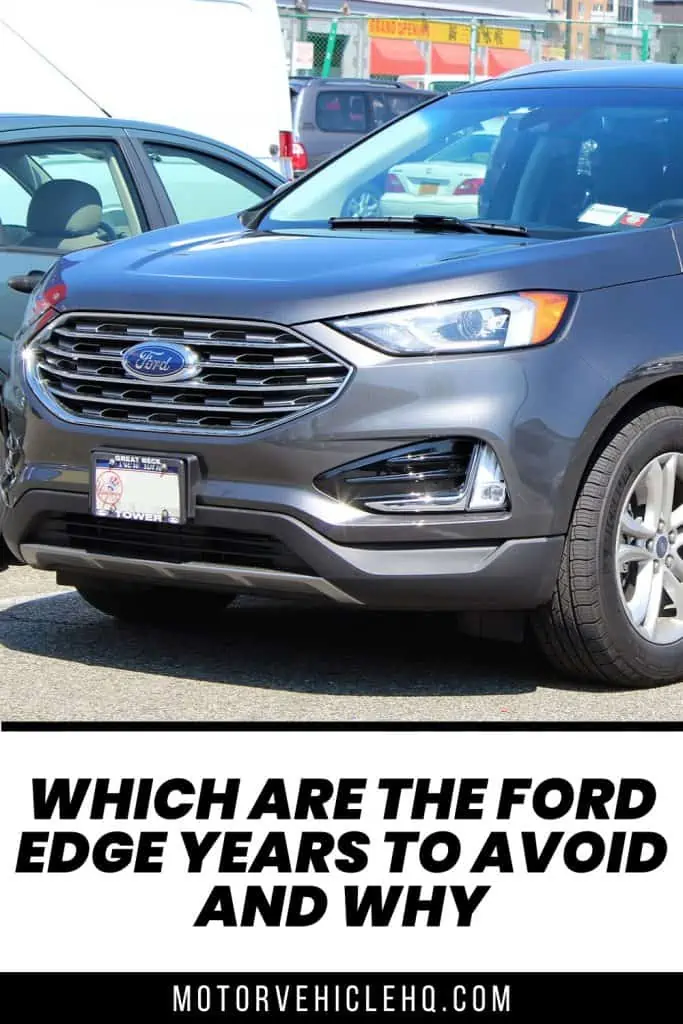
2019 Ford Edge SEL EcoBoost AWD by Kevauto / CC BY-SA 4.0

Jim Wicks is the founder of MotorVehicleHQ. With over two decades of experience in the automotive industry and a degree in Automotive Technology, Jim is a certified car expert who has worked in various roles ranging from a mechanic, car dealership manager, to a racing car driver. He has owned more than 20 cars over the past 15 years. Ask him about any vehicle you see on the road and he can tell you the make, model and year. He loves the aesthetics of all things cars, and keeps his vehicles in pristine condition.
In his free time, Jim enjoys getting his hands dirty under the hood of a classic car or taking long drives along the country roads. His favorite car? A 1967 Shelby GT500, a true classic that, according to Jim, “represents the pure essence of American muscle.”
